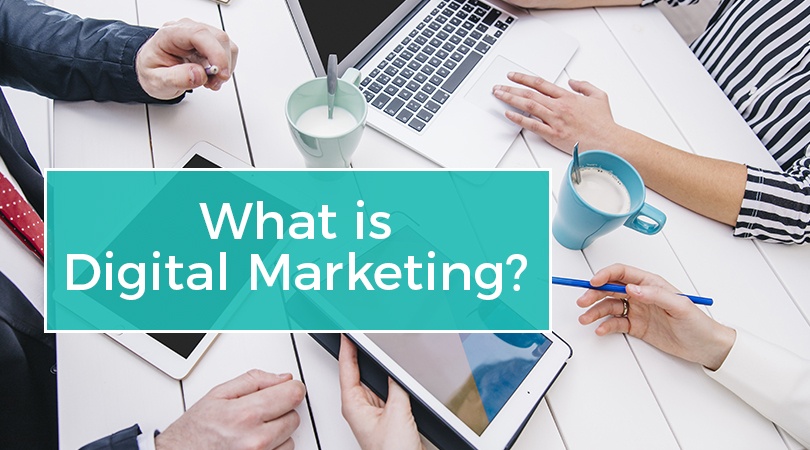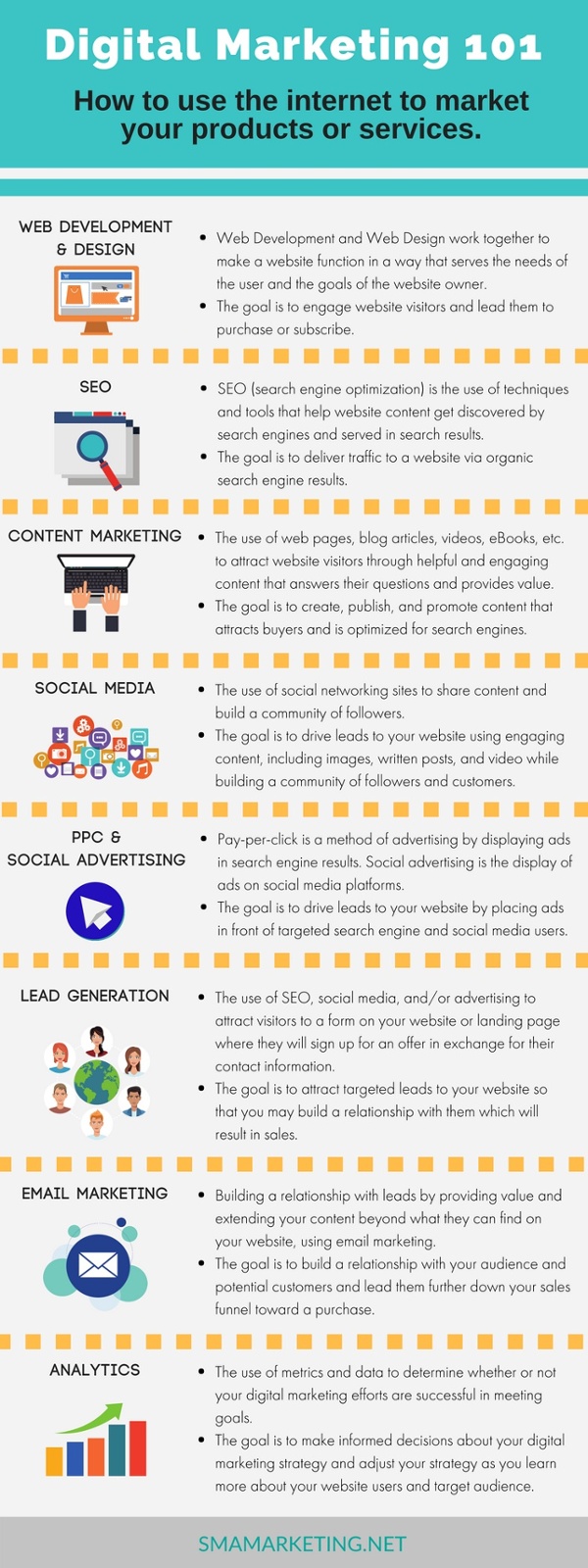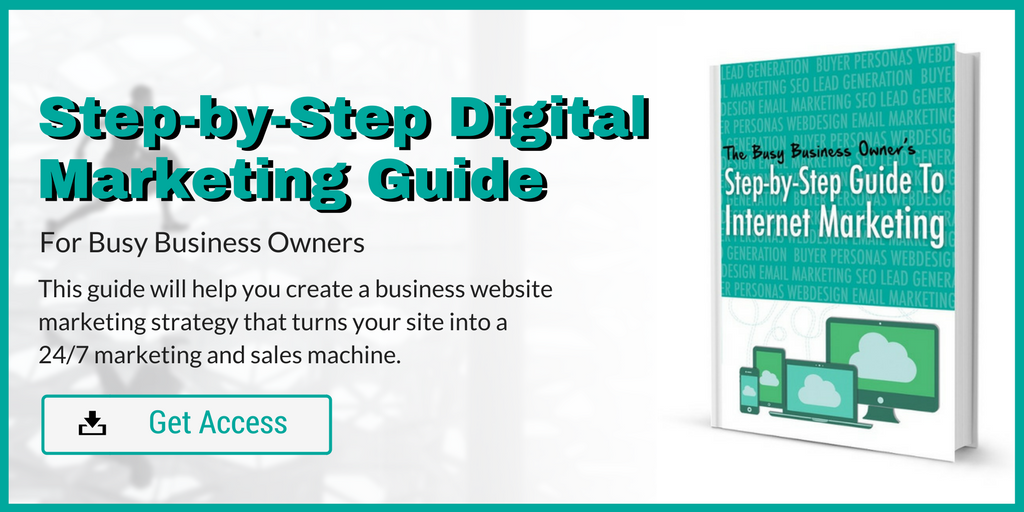
Digital marketing is the use of the internet to market your products or services. Digital marketing campaigns may include using social media, email, search engines, and a website or landing pages to engage with current and future customers.
People are spending more and more time online, searching for information and consuming content. It has become the backdrop of our lives. Need to find the answer to a question? Google it. Want to connect with family and friends? Interact with them on Facebook. Looking for ideas for your latest DIY project? Pinterest to the rescue.
The use of artificial intelligence, algorithms, and retargeting has given businesses direct access to consumers who are interested in their products and have become programmed to “click” to learn more. If your business isn’t already taking advantage of this opportunity to connect with customers, you’re at risk of lagging behind your competition.
This isn’t to say that digital marketing is all about big data and coding. The real success behind digital marketing is that it allows businesses to connect with potential customers in a personal way. The magic behind the marketing is that the data allows us to know our customers better and offer content that speaks to their needs and desires.
Beyond the message, though, there must be a company that provides top-notch service and customer care. Good digital marketing is an extension of a company’s mission and values.
So, what is digital marketing and what do you need to know to get started using it for your business? Here are the basics. I’ve broken digital marketing down into parts, each with a specific goal.
Digital Marketing 101
Web Development and Design
Web Development is the writing of code to make a website function in a way that serves the needs of the user and the goals of the website owner. Web Design is the design of the appearance of the website, and may also include coding.
The goal: Build a website that is engaging and follows good design and marketing principles to lead site users through your sales funnel to become subscribers or customers.
SEO
SEO (search engine optimization) incorporates the use of techniques and tools that help search engines discover website content and serve relevant content to search engine users. On-page SEO involves the use of tags and website structure to tell search engines what a website page is about. Off-page SEO tells search engines that your site has authority and is trustworthy. Such things as reviews and links to your content from authoritative sites, help boost your off-page SEO by letting search engines know your website contains quality information that is relevant to searchers.
The goal: Deliver traffic to a website via organic search engine results.
Content Marketing
The use of content such as web pages, blog articles, videos, social media posts, and eBooks to attract website visitors through helpful and engaging published information that answers their questions and provides value. For SEO to do its job, there must be relevant content on your website.
The goal: Create, publish, and promote content that attracts target buyers and helps search engines determine the relevance of that content in answering search queries.
Social Media
The use of social networking sites to share content and build a community of followers. Social media sites such as Facebook, LinkedIn, Twitter, YouTube, and Instagram are valuable lead generation tools for driving visitors to websites and landing pages.
The goal: Drive leads to your website using engaging content, including images, written posts, and video while building a community of followers and customers.
PPC and Social Advertising
Pay-per-click is a method of advertising by displaying ads in search engine results. Google PPC ads are based on targeted keywords. Advertisers pay when the ad is clicked by a search engine user. Social advertising is the display of ads on social media platforms. Advertisers select targeted audiences based on user behaviors and interests. Costs for social advertising are generally determined on a pay per click (PPC) basis, as well.
The goal: Place ads in front of targeted search engine and social media users. Drive leads to your website through the use of ads, without having to earn a spot in organic search results.
Lead Generation
The use of SEO, social media, and advertising to attract visitors to a form on your website or landing page where they will sign up for an offer in exchange for their contact information. The term lead magnet is sometimes used to refer to the free content that is offered as a download upon filling out a request or subscription form.
The goal: Attract relevant, targeted leads to your website so that you may build a relationship with them which will result in sales.
Lead Nurturing and Email Marketing
Once you have leads, you’ll want to build a relationship with them by providing value and extending your content beyond what they can find on your website. Email marketing is the main method of lead nurturing as it allows you to stay in front of your audience and customers on a consistent basis. If done well, lead nurturing, and email marketing help you build the “know, like, and trust” factor.
The goal: Build a relationship with your audience and potential customers and lead them further down your sales funnel toward a purchase.
Analytics
The use of metrics and data to determine whether or not your digital marketing efforts are successful in meeting goals and discovering where adjustments need to be made. Tools such as Google Analytics and Search Console reveal website use data that will help you make decisions about the efficacy of your digital marketing strategy and the effectiveness of your tactics.
The goal: Make informed decisions about your digital marketing strategy and adjust your strategy as you learn more about your website users and target audience.
Putting it all Together to Create a Digital Marketing Strategy
Now that you know what is involved in digital marketing, it’s time to put the pieces together to create a digital marketing strategy. Our Busy Business Owner’s Guide to Internet Marketing gives you helpful information to get started marketing your business online.

